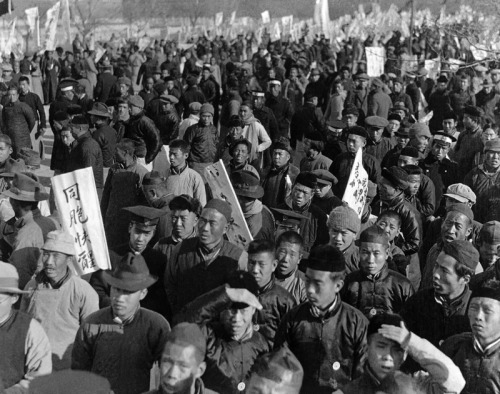May Fourth @ Tian’an Men, Beijing, 1919 The May Fourth Movement – so famous in China it
May Fourth @ Tian’an Men, Beijing, 1919 The May Fourth Movement – so famous in China it doesn’t need a year, although 1919 – the year it happened – has become legendary too. On that date, some three thousand students marched through Beijing demonstrating against Japanese imperialism and started a political movement that would become identified with Chinese demands for “science” and “democracy” through the next century. They shouted such slogans as “Struggle for the sovereignty externally, get rid of the national traitors at home”, “Do away with the ‘Twenty-One Demands’”, and “Don’t sign the Versailles Treaty”. They voiced their anger at the Allied betrayal of China, denounced the government’s spineless inability to protect Chinese interests, and called for a boycott of Japanese products. Demonstrators insisted on the resignation of three Chinese officials they accused of being collaborators with the Japanese. After burning the residence of one of these officials and beating his servants, student protesters were arrested, jailed, and severely beaten From the Cultural Revolution to Tian’an Men Square protests in 1986 and 1989, May Fourth echoes through China’s modern history. The Chinese Communist Party still claims the movement as its point of origin. Comprehensive analysis here Here are five ways into this fascinating topic – famous in China, little-known in the West. 1. Jonathan Spence, The Gate of Heavenly Peace (Viking Penguin 1981): still the classic account of the May Fourth generation and their revolution. Sweeping account that goes from the late Qing all the way to the end of the Cultural Revolution, with May Fourth intellectuals at its heart. 2. Lu Xun, Diary of a Madman. Iconic short story by China’s major modern writer, written on the eve of the seminal events of May Fourth, 1919. Searing indictment of traditional Confucian society. Translations into English by Gladys Yang and William Lyell. 3. Vera Schwarcz, The Chinese Enlightenment: Intellectuals and the Legacy of the May Fourth Movement of 1919 (1986). This is a fine academic account of the movement and its consequences – not for the beginner, but very subtle. 4. Chen Duxiu, “Call to Youth.” Chen’s call to China’s youth to “save the nation” in 1919 symbolizes the May Fourth Movement’s attempt to overcome Confucian attempts to venerate age and instead celebrate youth. 5. “Acting Out Democracy: Political Theater in Modern China,” Joseph W. Esherick and Jeffrey N. Wasserstrom, in Journal of Asian Studies (November 1990) – classic article on how the 1989 student protesters in China “acted out” their political protests with references to the past. -- source link
#beijing#tianan men#五四运动#students#student demonstration#chinese history#天安门广场

